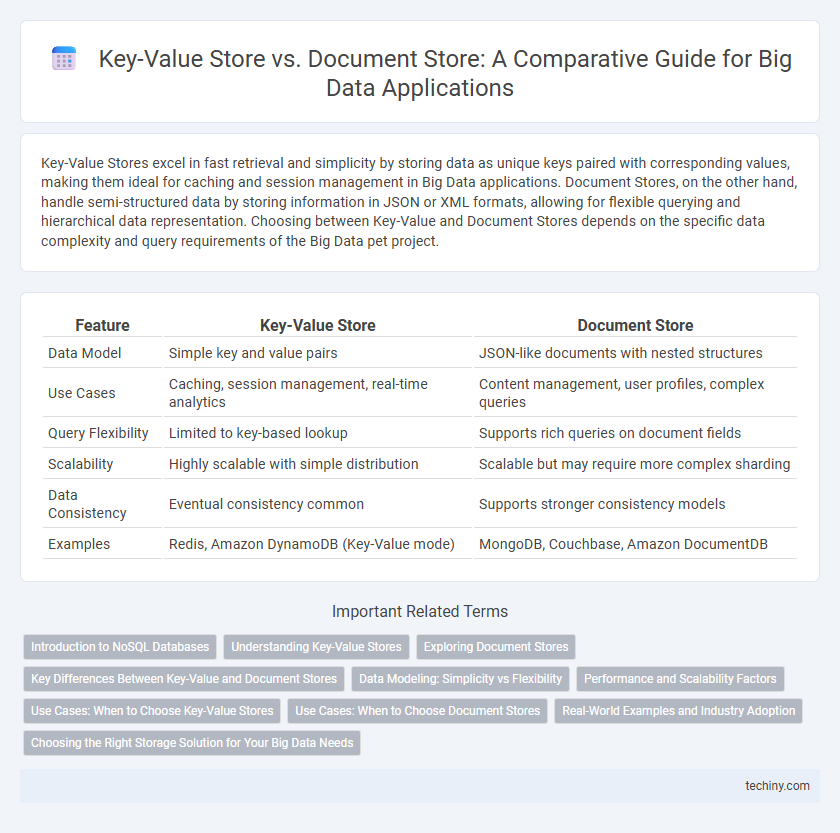Key-Value Stores excel in fast retrieval and simplicity by storing data as unique keys paired with corresponding values, making them ideal for caching and session management in Big Data applications. Document Stores, on the other hand, handle semi-structured data by storing information in JSON or XML formats, allowing for flexible querying and hierarchical data representation. Choosing between Key-Value and Document Stores depends on the specific data complexity and query requirements of the Big Data pet project.
Table of Comparison
| Feature | Key-Value Store | Document Store |
|---|---|---|
| Data Model | Simple key and value pairs | JSON-like documents with nested structures |
| Use Cases | Caching, session management, real-time analytics | Content management, user profiles, complex queries |
| Query Flexibility | Limited to key-based lookup | Supports rich queries on document fields |
| Scalability | Highly scalable with simple distribution | Scalable but may require more complex sharding |
| Data Consistency | Eventual consistency common | Supports stronger consistency models |
| Examples | Redis, Amazon DynamoDB (Key-Value mode) | MongoDB, Couchbase, Amazon DocumentDB |
Introduction to NoSQL Databases
Key-value stores and document stores are prominent types of NoSQL databases designed to handle large volumes of unstructured data in Big Data environments. Key-value stores organize data as a collection of key-value pairs, offering high-performance and scalability for simple retrieval tasks, while document stores manage data in flexible JSON-like documents, supporting complex queries and nested structures. Both types prioritize horizontal scaling and schema flexibility, making them essential for real-time analytics and large-scale data processing.
Understanding Key-Value Stores
Key-Value Stores excel in managing large volumes of data with simple key-based access, offering high performance and scalability in distributed systems. Each data item is stored as a key and its associated value, enabling rapid read and write operations, which makes them ideal for caching and session management. Their schema-less design allows flexibility but limits complex querying compared to Document Stores, which store semi-structured JSON-like documents for richer data representation.
Exploring Document Stores
Document stores excel in handling semi-structured data by storing information in flexible JSON-like formats, enabling efficient querying and indexing of nested attributes. Unlike key-value stores, which associate simple keys with opaque values, document stores support rich, hierarchical documents that facilitate complex data representations and retrieval. This flexibility makes document stores ideal for applications requiring dynamic schemas and rapid updates in big data environments.
Key Differences Between Key-Value and Document Stores
Key-value stores excel in simplicity and high-speed retrieval by associating unique keys with opaque data values, making them ideal for caching and session management. Document stores organize data into flexible, self-describing JSON or BSON documents that support complex queries and indexing, catering to applications requiring rich data models and schema evolution. The primary distinction lies in data structure handling: key-value stores treat values as uninterpreted blobs, whereas document stores parse and enable manipulation of document content.
Data Modeling: Simplicity vs Flexibility
Key-value stores excel in simplicity by storing data as unique keys with associated values, making them ideal for applications requiring fast lookups and straightforward data models. Document stores offer greater flexibility by managing semi-structured data in JSON or BSON formats, enabling complex nested objects and dynamic schemas that adapt to evolving data requirements. Choosing between key-value and document stores depends on the need for rapid, simple access versus versatile, schema-less data representation in big data environments.
Performance and Scalability Factors
Key-Value Stores excel in performance with their simple data model, enabling fast read and write operations ideal for large-scale caching and session management. Document Stores provide greater flexibility by supporting semi-structured data with nested fields, which can introduce overhead but enhance query capabilities and scalability for complex datasets. Scalability in Key-Value Stores is often achieved through straightforward sharding techniques, while Document Stores require more sophisticated indexing and partitioning to maintain performance at scale.
Use Cases: When to Choose Key-Value Stores
Key-Value Stores excel in use cases requiring rapid read and write operations with simple query patterns, such as caching, session management, and real-time data processing in IoT applications. Their schema-less nature and high scalability make them ideal for scenarios where data structure varies or evolves frequently. Enterprises handling massive volumes of user preferences or shopping cart data benefit from Key-Value Stores due to their low-latency access and efficient storage model.
Use Cases: When to Choose Document Stores
Document stores excel in handling semi-structured data like JSON or XML, making them ideal for content management systems, e-commerce platforms, and real-time analytics where data schemas frequently evolve. Their flexible document model supports complex queries, nested data, and indexing on various fields, enabling efficient retrieval in applications involving user profiles, product catalogs, and event logging. Selecting document stores is advantageous when the use case demands agile schema design and rich querying capabilities beyond simple key-based retrieval found in key-value stores.
Real-World Examples and Industry Adoption
Amazon DynamoDB exemplifies key-value stores by providing high-speed, scalable storage for applications requiring low-latency data access, widely adopted in e-commerce and gaming industries. MongoDB represents document stores, handling semi-structured JSON-like documents with flexible schemas, favored by healthcare and content management sectors for complex data queries. Both databases power large-scale systems, with key-value stores excelling in speed and simplicity, while document stores offer richer querying capabilities for evolving data models.
Choosing the Right Storage Solution for Your Big Data Needs
Key-value stores excel in handling massive volumes of simple, schema-less data with high-speed read/write operations, making them ideal for caching and session management in Big Data environments. Document stores, on the other hand, provide flexible, JSON-like document structures that support complex queries and dynamic schemas, perfect for applications requiring rich data modeling and rapid iteration. Selecting between key-value and document stores depends on data complexity, query requirements, and scalability needs to optimize Big Data storage solutions.
Key-Value Store vs Document Store Infographic

 techiny.com
techiny.com